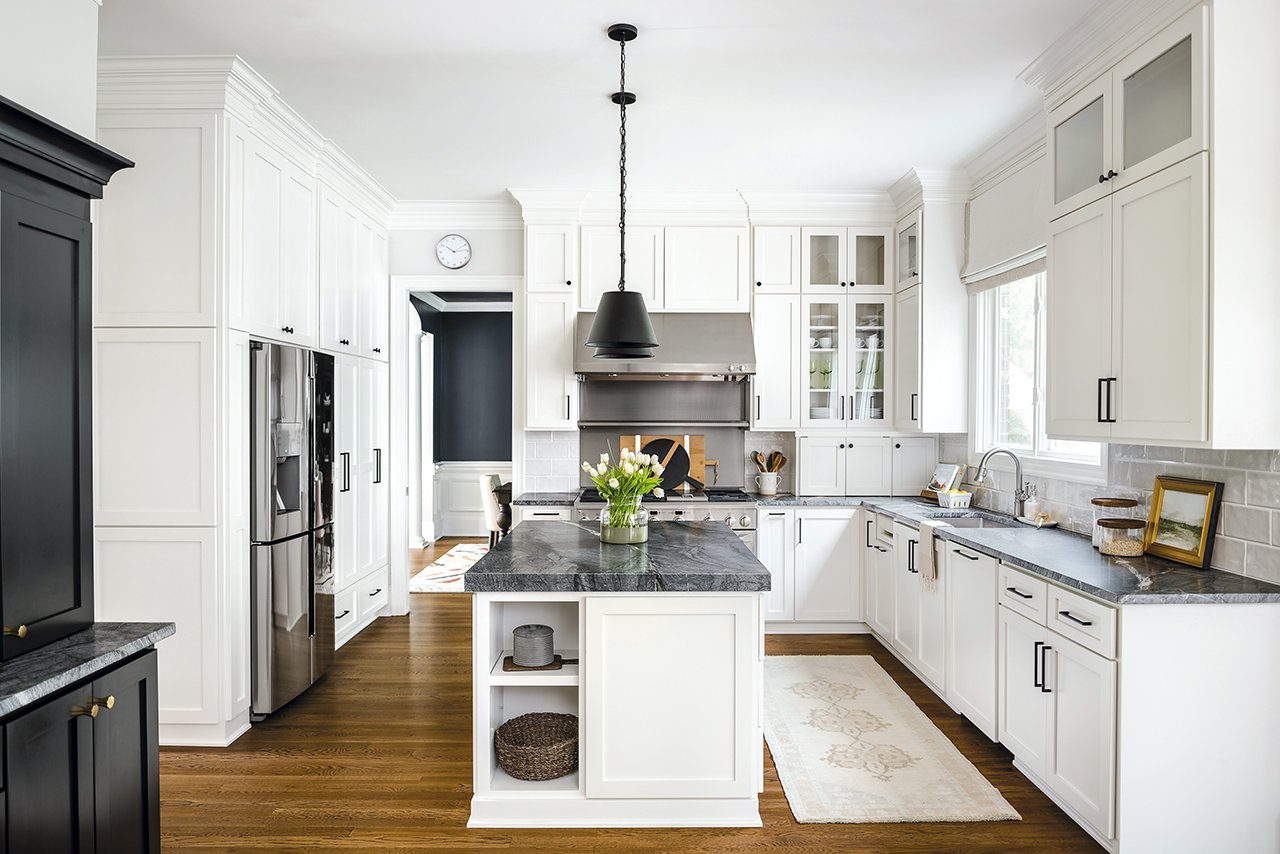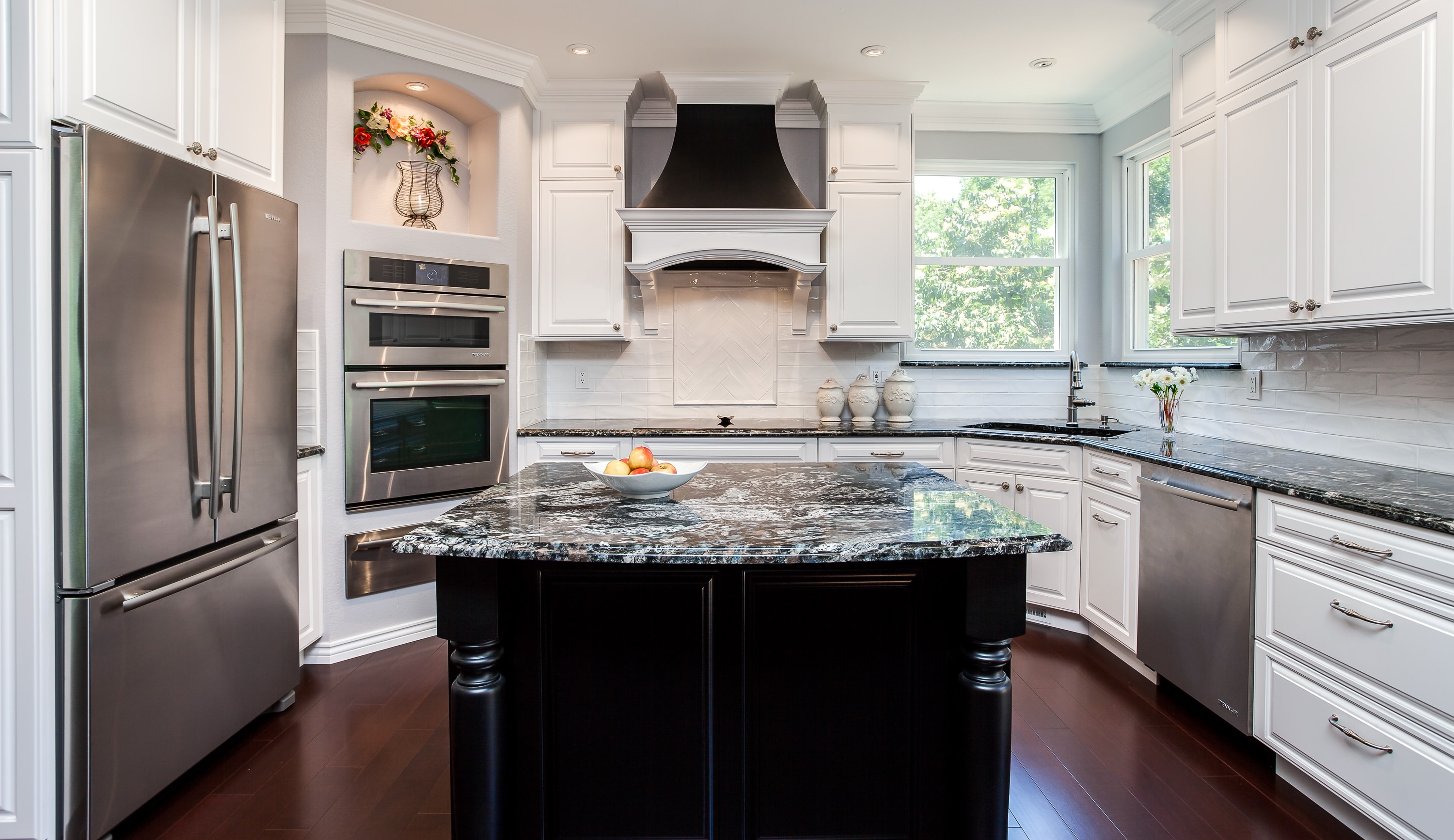Aesthetic Considerations

The choice between dark and light countertops can significantly impact the overall aesthetic of a kitchen with white cabinets. Both options offer distinct advantages and drawbacks, influencing the perception of space, brightness, and warmth.
The Impact of Dark Countertops
Dark countertops, such as black, charcoal, or dark brown, create a dramatic and sophisticated look in a kitchen with white cabinets. The high contrast between the dark countertops and the white cabinets adds visual interest and makes the space feel more defined. This contrast can also create a sense of depth, making the kitchen appear larger than it actually is. Dark countertops can also make a kitchen feel more modern and sleek, especially when paired with sleek, minimalist cabinetry. However, dark countertops can also make a kitchen feel smaller and darker, especially if the space is already small or has limited natural light.
The Impact of Light Countertops
Light countertops, such as white, cream, or light gray, create a bright and airy feel in a kitchen with white cabinets. The light colors reflect light, making the space feel larger and brighter. Light countertops can also create a more traditional or classic feel, especially when paired with traditional cabinetry. However, light countertops can also show dirt and stains more easily than dark countertops, requiring more frequent cleaning. They can also make a kitchen feel less dramatic and less interesting.
Comparing and Contrasting the Visual Impact
- Space Perception: Dark countertops can make a kitchen feel smaller, while light countertops can make a kitchen feel larger. This is because dark colors absorb light, while light colors reflect light.
- Brightness: Dark countertops can make a kitchen feel darker, while light countertops can make a kitchen feel brighter. This is because dark colors absorb light, while light colors reflect light.
- Warmth: Dark countertops can make a kitchen feel more dramatic and sophisticated, while light countertops can make a kitchen feel more traditional and classic.
Kitchen Layout with White Cabinets and Dark Countertops
Imagine a modern kitchen with white shaker cabinets and sleek black quartz countertops. The dark countertops provide a striking contrast to the white cabinets, creating a sophisticated and modern look. The backsplash could be a light-colored subway tile, adding a touch of brightness and visual interest. The kitchen island could be painted a deep gray or black to match the countertops, creating a cohesive look. Stainless steel appliances would complement the dark countertops and white cabinets. The overall effect is a modern, sleek, and sophisticated kitchen.
Kitchen Layout with White Cabinets and Light Countertops
Consider a traditional kitchen with white cabinets and white marble countertops. The light countertops reflect light, making the space feel larger and brighter. The backsplash could be a white or cream-colored tile with a subtle pattern, adding a touch of elegance. The kitchen island could be painted a soft gray or white to match the countertops, creating a cohesive look. Brass hardware on the cabinets and appliances would add warmth and sophistication. The overall effect is a traditional, elegant, and airy kitchen.
Practical Considerations

Choosing between dark and light countertops for your white cabinets involves more than just aesthetics. Practical considerations like maintenance, cleaning, and durability play a crucial role in your decision. Let’s delve into the pros and cons of each option.
Maintenance and Cleaning of Dark Countertops
Dark countertops, while adding a dramatic flair to your kitchen, can be more demanding in terms of maintenance and cleaning. Here’s a breakdown:
- Pros:
- Darker shades can help mask minor imperfections and scratches, making them appear less noticeable.
- They can create a sense of depth and sophistication in your kitchen.
- Cons:
- Dust, crumbs, and fingerprints are more visible on dark surfaces, requiring frequent cleaning.
- Watermarks and stains can be more prominent on dark countertops, especially if the material is porous.
- Scratches and chips can be more noticeable on dark surfaces, impacting the overall appearance.
Maintenance and Cleaning of Light Countertops
Light countertops, on the other hand, offer a brighter and more airy feel, but they come with their own set of maintenance considerations:
- Pros:
- Light surfaces tend to show less dirt and grime, requiring less frequent cleaning.
- They can make a small kitchen appear larger and more spacious.
- Cons:
- Scratches and stains are more noticeable on light surfaces.
- Light countertops can easily show watermarks and streaks, requiring careful drying after cleaning.
- They may require more frequent cleaning to maintain their pristine appearance.
Durability and Resistance to Scratches and Stains, Dark or light countertops with white cabinets
The durability and resistance to scratches and stains vary significantly depending on the countertop material.
- Dark Countertops:
- Granite: A highly durable and scratch-resistant option, but susceptible to etching from acidic substances.
- Quartz: Non-porous and extremely durable, resisting scratches, stains, and heat. However, it can be susceptible to chipping.
- Soapstone: A naturally soft stone, prone to scratches and stains, but its durability can be enhanced with proper sealing.
- Light Countertops:
- Marble: A beautiful but delicate material, susceptible to scratches, stains, and etching from acidic substances.
- Quartzite: A highly durable and scratch-resistant option, but can be expensive.
- Laminate: An affordable and durable option, but susceptible to scratches and heat damage.
Maintaining the Appearance of Dark Countertops
To keep your dark countertops looking their best, follow these tips:
- Regular Cleaning: Clean your countertops daily with a mild cleaner and a soft cloth. Avoid harsh chemicals and abrasive cleaners that can damage the surface.
- Sealing: Regularly seal porous materials like granite and soapstone to prevent stains and enhance durability.
- Use Cutting Boards: Always use cutting boards to protect the countertop surface from scratches and knife marks.
- Wipe Up Spills Immediately: Promptly wipe up spills to prevent staining, especially acidic substances like wine or juice.
Maintaining the Appearance of Light Countertops
For light countertops, these maintenance tips are essential:
- Regular Cleaning: Clean your countertops regularly with a mild cleaner and a soft cloth. Avoid abrasive cleaners that can scratch the surface.
- Use Coasters: Place coasters under glasses and hot dishes to prevent watermarks and heat damage.
- Dry Immediately: After cleaning or spilling water, dry the surface immediately to prevent watermarks.
- Use Cutting Boards: Always use cutting boards to protect the countertop surface from scratches and knife marks.
Popular Material Choices: Dark Or Light Countertops With White Cabinets

Choosing the right countertop material is a crucial decision in any kitchen renovation. It significantly impacts the overall look, feel, and functionality of your space. We’ll explore the most popular options for both dark and light countertops, highlighting their pros, cons, and costs to help you make an informed choice.
Dark Countertop Materials
Dark countertops offer a dramatic and sophisticated look, creating a striking contrast against white cabinets. They can also make a small kitchen appear larger by visually expanding the space. Here’s a breakdown of popular dark countertop materials:
| Material | Pros | Cons | Typical Cost (per sq ft) |
|---|---|---|---|
| Black Granite |
|
|
$60 – $150 |
| Soapstone |
|
|
$70 – $180 |
| Black Quartz |
|
|
$50 – $120 |
| Black Laminate |
|
|
$20 – $50 |
Light Countertop Materials
Light countertops provide a bright and airy feel to your kitchen, complementing white cabinets beautifully. They can also create a sense of spaciousness, especially in smaller kitchens. Here’s a look at popular light countertop materials:
| Material | Pros | Cons | Typical Cost (per sq ft) |
|---|---|---|---|
| White Marble |
|
|
$80 – $200 |
| White Quartz |
|
|
$60 – $150 |
| White Caesarstone |
|
|
$70 – $180 |
| White Laminate |
|
|
$20 – $50 |
Design Considerations
The choice of countertop material can significantly impact the overall aesthetic of your kitchen. For example, black granite with its dramatic veining patterns adds a touch of elegance and sophistication to a modern kitchen. White marble with its subtle veining provides a classic and timeless look that complements traditional and farmhouse styles. Quartz, with its wide range of colors and patterns, offers versatility for any kitchen design.
Natural Stone vs. Engineered Stone
Natural stone, such as granite and marble, offers unique beauty and durability. However, it requires regular sealing to prevent staining and scratches. Engineered stone, like quartz, is a man-made material that is non-porous and stain-resistant, making it a more practical choice for busy kitchens. While natural stone provides a unique and timeless look, engineered stone offers greater durability and ease of maintenance. Ultimately, the best choice depends on your individual needs and preferences.
Dark or light countertops with white cabinets – The debate between dark and light countertops with white cabinets is a classic, but don’t forget about the unexpected beauty of a bold cabinet color. Dark olive green cabinets add a touch of sophistication and grounding, and they pair beautifully with both light and dark countertops, offering a unique and elegant twist to the traditional kitchen design.
The classic combination of white cabinets and either dark or light countertops offers endless possibilities for kitchen design. But for a truly timeless and sophisticated look, consider the elegance of soapstone countertops with dark cabinets. The rich, earthy tones of soapstone create a striking contrast against the dark cabinetry, while the natural veining adds visual interest.
Ultimately, whether you prefer a bright and airy kitchen or a cozy and inviting space, the right countertop choice can elevate the entire aesthetic.